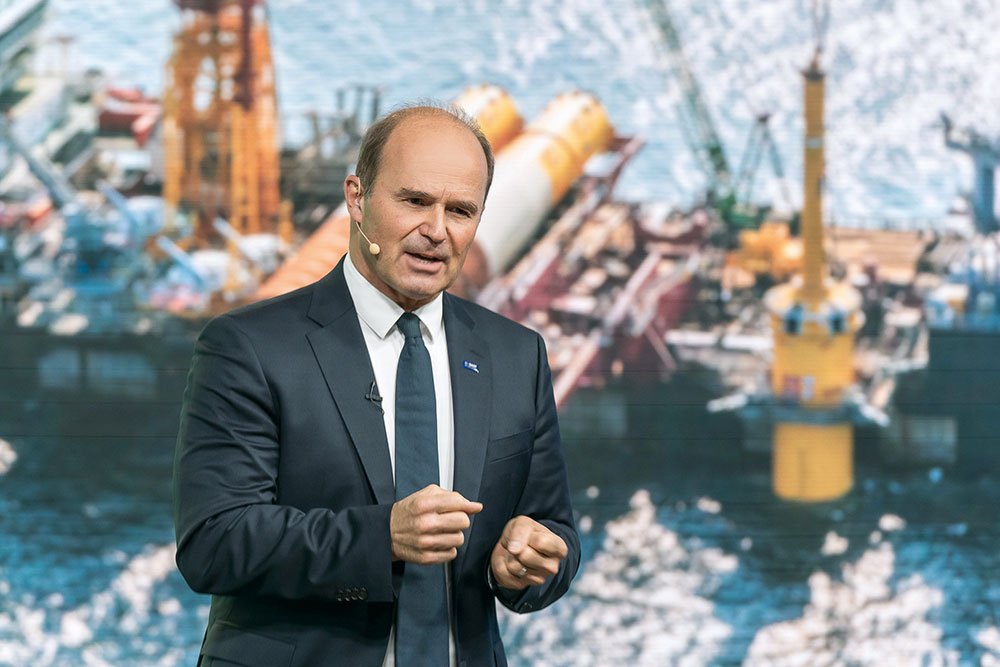Martin Brudermüller, CEO of BASF SE
Fraunhofer magazine 4/2023
Everyone agrees on the goal: Europe will become the first climate-neutral continent by 2050. However, there is still debate around how to achieve the great task of this century. One thing is clear, though: It cannot happen without a strong and competitive chemical industry.
The chemical industry is undergoing the greatest transformation in its history. This industry, one of the most emissions- and energy-intensive, is aiming for climate neutrality. This demands not only ground-breaking innovations, but also suitable framework conditions and political pragmatism. BASF is backing the Green Deal. That is why we are doing our utmost to achieve net-zero carbon emissions by 2050. But what will the future of chemistry look like at BASF?
The chemical industry is everywhere. It is the “industry of industries” and supplies its products to almost every sector. Chemistry is the place where we most need to make things greener. Resins make wind farms weatherproof. Solar plants can only function with the help of electronic chemicals, while electric mobility is dependent on battery materials.
However, the chemical industry also generates a high level of CO2 emissions. We are changing this. An important driver here is the shift in our electricity and steam supply from gray to green. For example, only a few weeks ago, one of the world’s biggest offshore wind farms commenced operations off the Dutch coast with the participation of BASF – and without any subsidization. Around half of the green electricity generated there flows to our locations in Europe. Our new collaborative site, located in the southern Chinese city of Zhanjiang, will be powered by 100 percent green electricity from day one.
In addition, to reduce CO22 emissions during production, we are developing and trialling new technologies in pilot projects – our primary focus here is on basic chemicals, the emissions-intensive fundamental building blocks that make up thousands of our products. For example, the world’s first pilot plant for electrically powered steam cracker furnaces will commence operations in Ludwigshafen in early 2024. With this technology, we can reduce the CO2 emissions generated during ethylene and propylene production by more than 90 percent. We are also testing the possibility of using water electrolysis on an industrial scale to replace the carbon-intensive steam reformation process in hydrogen production.
Reducing CO2 emissions during production means we can in turn offer our customers products with a reduced carbon footprint, thus supporting them in achieving their own climate protection goals. We regularly calculate the carbon footprint of all BASF’s 45,000 commercial products. On the basis of this information, we optimize our processes, increase our efforts to use low-carbon, renewable raw materials and expand our portfolio of low-carbon products.
We at BASF are willing to strive toward climate neutrality, and we are on the right road to achieve this. However, we are reliant on the government doing its homework too. They need to ensure that climate protection and competitiveness go hand in hand. There are four crucial elements here:
First – more pragmatism. Europe already has one of the world’s most comprehensive and effective chemical regulation systems. With the Green Deal, this system is becoming even more extensive: It has already consists of some 14,000 pages. However, instead of using regulations as a sledgehammer, we need to introduce a set of guidelines that can be implemented pragmatically.
Second – more speed. Almost all climate-friendly technologies are based on green energy. We therefore need a greatly accelerated plan to extend the use of renewables throughout Europe. The suggested approaches for speeding up planning and approval procedures are promising. Now, these must become a reality, and quickly.
Third – more openness. Many technologies for achieving a climate-neutral future are as yet unknown to us. We must therefore remain open to new ideas, rather than hindering innovation by labeling some as off-limits. Unfortunately, we in Europe have a mania for discussing potential dangers and prohibiting new technologies – instead of conducting a rational risk assessment and exploiting the opportunities they present.
Fourth – more incentives for investment. Restructuring the industry in a climate-neutral way is a costly process. The problem is that investments often lack a business model. Despite this, we at BASF are still getting involved – out of entrepreneurial responsibility and in the spirit of the global innovation race. Nevertheless, living laboratories and non-bureaucratic support are needed to generate growth from innovative ways of thinking. What’s more, pioneering work must be profitable. The USA has given an impressive demonstration of how incentive schemes can be used with the Inflation Reduction Act.
The goal of industry, government and society should be a green transformation that links climate protection, innovation and competitiveness in a pragmatic and effective way. This is the only way to make an ambitious vision into a success story for everyone.
